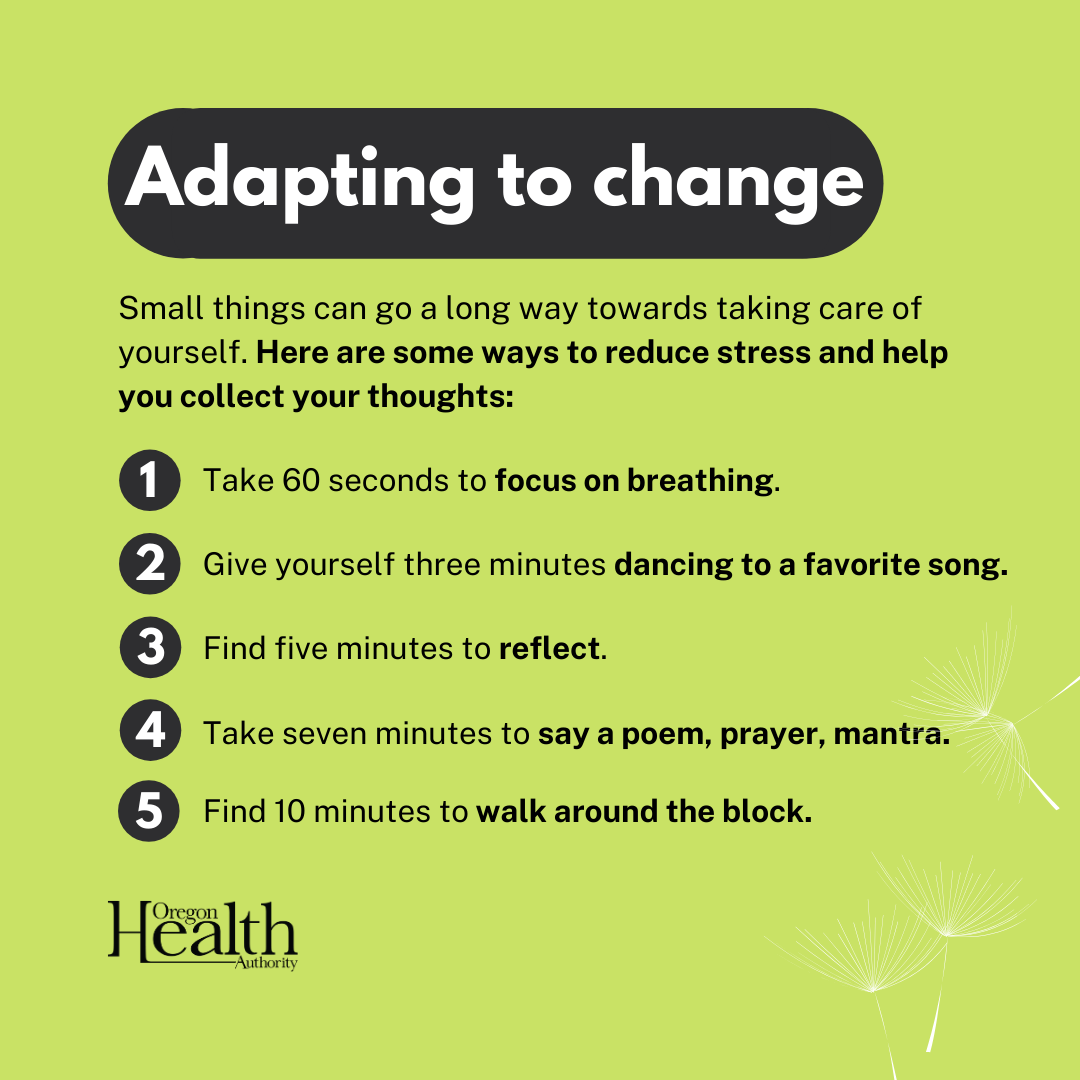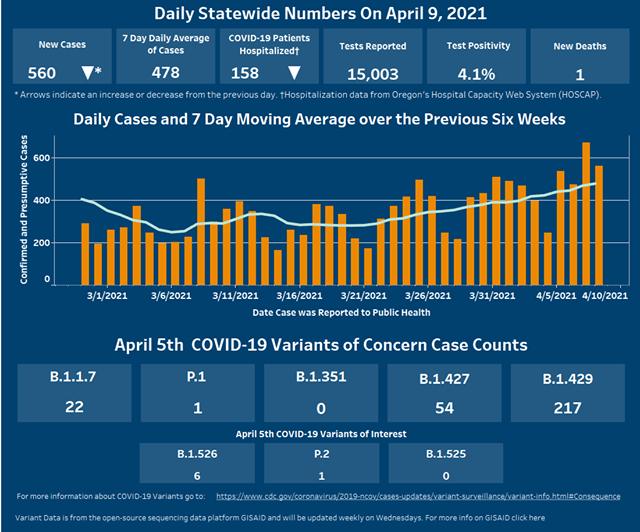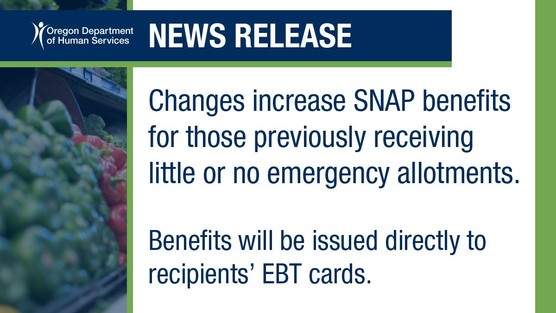There is one new COVID-19 related death in Oregon, raising the state’s death toll to 2,440, the Oregon Health Authority reported today April 9, 2021.
Oregon Health Authority reported 560 new confirmed and presumptive cases of COVID-19, bringing the state total to 169,338.
The new confirmed and presumptive COVID-19 cases reported are in the following counties: Baker (3), Benton (3), Clackamas (51), Clatsop (6), Columbia (7), Curry (7), Deschutes (51), Douglas (8), Grant (24), Harney (1), Hood River (1), Jackson (27), Jefferson (6), Josephine (18), Klamath (25), Lake (2), Lane (47), Lincoln (9), Linn (17), Malheur (2), Marion (33), Multnomah (97), Polk (11), Tillamook (3), Umatilla (10), Union (3), Wallowa (1), Wasco (1), Washington (83) and Yamhill (3).
Back to school – parents giving it their all and adapting to change
There’s no doubt about it, parents and caregivers in Oregon have had a long year with most children attending school online. You scrambled to find care for children while leaving home to do critical frontline jobs or struggled to find time and space to work from home while still supporting children’s learning. Many of you lost jobs or lost homes. Sadly, some lost loved ones.
Amidst a time when change is the only certainty, you are doing your best to provide stability for your children. Many of you are putting all your effort into getting through each day.
As we begin to open more schools to both in-person and hybrid education it’s helpful to remember that change can be difficult and may provoke anxiety. Small things can go a long way towards taking care of yourself and making best decisions for children and family.
- Take 60 seconds to focus on breathing.
- Give yourself three minutes dancing to a favorite song.
- Find five minutes to reflect.
- Seven minutes to say a poem, prayer, mantra.
- Ten minutes to walk around the block.
Each of these can reduce stress and help you collect your thoughts.
Giving yourself the time and space to ask yourself what you need is a first step. Here are some questions to think about:
- Are there ways that I can slow down?
- What am I really feeling? What worries me, what gives me hope?
- What do I need? What do I need to prioritize and what do I need to defer?
- Who are the people and organizations that support me?
- Am I living into my values and priorities?
- What can I do to lower my and my children’s risk for COVID-19?
- Am I ready for this change? It’s okay to take some time to decide this.
Thinking of concrete methods of how to get support and lower risk can help to manage anxiety. Slowing down can give you a break from stress and build resilience. It also is helpful to remember that you or your children might not be ready to change your school routine. It’s okay to wait until you are.
You are not alone. The Safe + Strong Helpline at 1-800-923-HELP (4357) can help you find the resources you need. Help is free and available 24/7.

![]()
Viral vectors teach your body how to fight off COVID-19
Some SNAP recipients may see an increase in benefits this month
In April, some folks who receive help with food from the Supplemental Nutrition Assistance Program (SNAP) will see a change to their benefit amount for emergency allotments (EA). Since March 2020, some SNAP households have received EA for additional support during the COVID-19 pandemic. But some households that are at or near the maximum SNAP benefit were receiving little or no additional support. The April 2021 changes provide an increase in benefits to those who were previously receiving little or no EA.
EA benefits will be dispersed on April 13 for current SNAP households and April 30 for SNAP households who did not receive the first EA payment or who are now eligible for a minimum $95 EA payment.
SNAP recipients do not have to take any action to receive these supplemental benefits as they will be issued directly on their EBT cards. Total benefits will be different based on each household’s regular monthly allotment for the month of March.
More information about emergency allotments is available at https://www.oregon.gov/dhs/ASSISTANCE/FOOD-BENEFITS/Pages/About-SNAP.aspx.
Questions about your SNAP benefits should be directed to your local office or by calling the ONE customer service center at 1-800-699-9075.
Learn more about SNAP benefits at https://govstatus.egov.com/or-dhs-benefits. For local resources in your area, such as food or shelter, please call 2-1-1 or reach out to the state’s Aging and Disability Resource Connection (ADRC) at 1-855-ORE-ADRC or 1-855-673-2372.
Vaccination data for counties now available
Vaccination data showing the status of COVID-19 vaccinations at the county level is now available on OHA’s vaccination dashboard. It was temporarily disabled last week. OHA resolved an issue with its geocoding process, which had previously miscategorized the location of certain vaccinated individuals.
OHA continually analyzes all its data and performs ongoing data quality checks. Vaccination data requests that included county of residence were delayed due to this issue.
Vaccinations in Oregon
Today, OHA reported that 53,121 new doses of COVID-19 vaccinations were added to the state immunization registry. Of this total, 33,410 doses were administered on April 8 and 19,711 were administered on previous days but were entered into the vaccine registry on April 8. Cumulative daily totals can take several days to finalize.
Oregon has now administered a total of 1,108,731 doses of Pfizer, 993,824 doses of Moderna and 67,071 doses of Johnson & Johnson COVID-19 vaccines. As of today, 859,912 people have completed a COVID-19 vaccine series. There are 1,374,408 people who have had at least one dose.
To date, 1,363,635 doses of Pfizer, 1,215,300 doses of Moderna and 193,200 doses of Johnson & Johnson COVID-19 vaccines have been delivered to sites across Oregon.
These data are preliminary and subject to change. OHA’s dashboards provide regularly updated vaccination data, and Oregon’s dashboard has been updated today.
COVID-19 hospitalizations
The number of hospitalized patients with COVID-19 across Oregon is 158, which is 10 fewer than yesterday. There are 39 COVID-19 patients in intensive care unit (ICU) beds, which is one more than yesterday.
The total number of patients in hospital beds may fluctuate between report times. The numbers do not reflect admissions per day, nor the length of hospital stay. Staffing limitations are not captured in this data and may further limit bed capacity.
Learn more about COVID-19 vaccinations
To learn more about the COVID-19 vaccine situation in Oregon, visit our webpage (English or Spanish), which has a breakdown of distribution and other information.


 (1).png)

